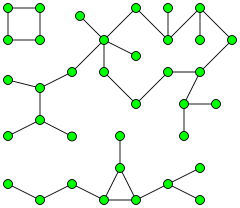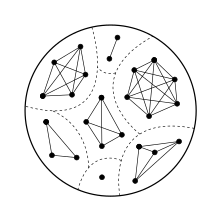有3個元件的圖 在圖論 中,元件 (英語:Component )又稱為連通元件 、元件 、或分支 [ 1]
如果圖是一個有向圖,而每2個頂點都存在可以來回該頂點的路徑則稱為強連通元件 ;而若圖上任兩個點之間皆有不止一條路徑連通,則稱為雙連通元件
有七个分量的聚类图 无向图的连通分量的定义是一个连通子图,且其不是某个更大的连通子图的一部分。例如,第一幅图有三个分量。图的每个顶点
v
{\displaystyle v}
v
{\displaystyle v}
可到达 导出子图 。[ 2] 不相交并 [ 3]
分量的另一个定义涉及定义在图的顶点上的等价关系 的等价类。在无向图中,如果有一条从
u
{\displaystyle u}
v
{\displaystyle v}
路径 ,那么顶点
u
{\displaystyle u}
v
{\displaystyle v}
可达性是一种等价关系,因为:
它是自反关系 。从任何顶点到它本身都有一条长度为零的平凡路径。
它是对称关系 。如果有一条从
u
{\displaystyle u}
v
{\displaystyle v}
v
{\displaystyle v}
u
{\displaystyle u}
它是传递关系 。如果有一条从
u
{\displaystyle u}
v
{\displaystyle v}
v
{\displaystyle v}
w
{\displaystyle w}
u
{\displaystyle u}
w
{\displaystyle w}
这种关系的等价类 将图的顶点划分为不相交集 ,即顶点的子集,这些子集相互之间都是可达的,在这些子集之外没有额外的可达对。每个顶点正好属于一个等价类。那么,分量就是这些等价类中的每一个所形成的导出子图 。[ 8] [ 9]
^ Diestel. 图论 (PDF) . (原始内容存档 (PDF) 于2019-05-03). ^ Clark, John; Holton, Derek Allan, A First Look at Graph Theory , Allied Publishers: 28, 1995 [2022-11-06 ] , ISBN 9788170234630存档 于2022-01-08) ^ Joyner, David; Nguyen, Minh Van; Phillips, David, 1.6.1 Union, intersection, and join , Algorithmic Graph Theory and Sage 0.8-r1991, Google: 34–35, May 10, 2013 [2022-11-06 ] , (原始内容存档 于2016-01-16) ^ 4.0 4.1 Tutte, W. T., Graph Theory , Encyclopedia of Mathematics and its Applications 21 , Reading, Massachusetts: Addison-Wesley: 15, 1984 [2022-11-06 ] , ISBN 0-201-13520-5MR 0746795 存档 于2022-01-07) ^ Thulasiraman, K.; Swamy, M. N. S., Graphs: Theory and Algorithms , John Wiley & Sons: 9, 2011 [2022-11-06 ] , ISBN 978-1-118-03025-7存档 于2022-01-07) ^ Bollobás, Béla, Modern Graph Theory , Graduate Texts in Mathematics 184 , New York: Springer-Verlag: 6, 1998 [2022-11-06 ] , ISBN 0-387-98488-7MR 1633290 doi:10.1007/978-1-4612-0619-4 存档 于2022-01-08) ^ McColl, W. F.; Noshita, K., On the number of edges in the transitive closure of a graph, Discrete Applied Mathematics, 1986, 15 (1): 67–73, MR 0856101 doi:10.1016/0166-218X(86)90020-X ^ Foldes, Stephan, Fundamental Structures of Algebra and Discrete Mathematics , John Wiley & Sons: 199, 2011 [2022-11-06 ] , ISBN 978-1-118-03143-8存档 于2022-01-07) ^ Siek, Jeremy; Lee, Lie-Quan; Lumsdaine, Andrew, 7.1 Connected components: Definitions, The Boost Graph Library: User Guide and Reference Manual, Addison-Wesley: 97–98, 2001
Hopcroft, J. ; Tarjan, R. , Algorithm 447: efficient algorithms for graph manipulation, Communications of the ACM , 1973, 16 (6): 372–378, doi:10.1145/362248.362272 Lewis, Harry R.; Papadimitriou, Christos H. , Symmetric space-bounded computation, Theoretical Computer Science, 1982, 19 (2): 161–187, doi:10.1016/0304-3975(82)90058-5 Reingold, Omer, Undirected connectivity in log-space, Journal of the ACM , 2008, 55 (4): Article 17, 24 pages, doi:10.1145/1391289.1391291 Shiloach, Yossi; Even, Shimon, An on-line edge-deletion problem, Journal of the ACM , 1981, 28 (1): 1–4, doi:10.1145/322234.322235




